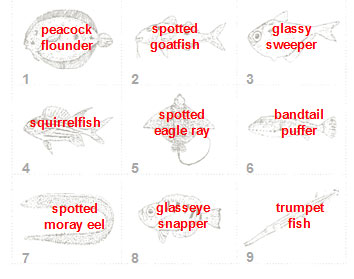If there are over 10 million different species on Earth, how do scientists identify those organisms? How can the organisms be identified?
The answer to these questions is “by using a dichotomous key.” A dichotomous key is a tool that allows the user to determine the identity of items in the natural world, such as trees, wildflowers, mammals, reptiles, rocks, and fish. Dichotomous keys are made up of a series of steps that enable the user to identify the unknown item. The word dichotomous means "divided into two parts." Each step in the key gives descriptions of two distinguishing characteristics and includes direction to another stage in the key. The user goes through the steps in order until the identity is determined.
The following is an example a dichotomous key for identifying fish that might be found in the Great Barrier Reef.
![]() Click on each image in the key to see a more detailed picture of each fish.
Click on each image in the key to see a more detailed picture of each fish.
![]() Watch the following video to see a teacher go through the key to identify two of the fish pictured.
Watch the following video to see a teacher go through the key to identify two of the fish pictured.
Source: Dichotomous Keys USE, RTHSBiology, YouTube
Use the key to identify the remaining fish. Follow these guidelines when using a dichotomous key.
Interactive popup. Assistance may be required.


Source: Fish Sorting, Treasures of the Great Barrier Reef, NOVA, PBS
Sources used in the interactive images, as they appear: